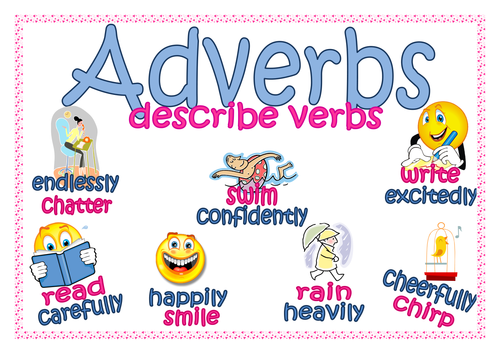The adverbs in English Grammar – Summary
1. The adverbs and the adjectives in English
Adjectives tell us something about a person or a thing. Adjectives can modify nouns (here: girl) or pronouns (here: she).
Adverbs tell us in what way someone does something. Adverbs can modify verbs (here: drive), adjectives or other adverbs.
| adjective | adverb |
|---|---|
| Mandy is a careful girl. | Mandy drives carefully. |
| She is very careful. | She drives carefully. |
Mandy is a careful driver. This sentence is about Mandy, the driver, so use the adjective.
Mandy drives carefully. This sentence is about her way of driving, so use the adverb.
2. Form
Adjective + -ly
| adjective | adverb |
|---|---|
| dangerous | dangerously |
| careful | carefully |
| nice | nicely |
| horrible | horribly |
| easy | easily |
| electronic | electronically |
Irregular forms:
| adjective | adverb |
|---|---|
| good | well |
| fast | fast |
| hard | hard |
If the adjective ends in -y, change -y to -i. Then add -ly:
- happy – happily
but:
- shy – shyly
If the adjective ends in -le, the adverb ends in -ly:
- terrible – terribly
If the adjective ends in -e, then add -ly:
- safe – safely
► Not all words ending in -ly are adverbs:
- adjectives ending in -ly: friendly, silly, lonely, ugly
- nouns, ending in -ly: ally, bully, Italy, melancholy
- verbs, ending in -ly: apply, rely, supply
There is no adverb for an adjective ending in -ly.
3. Use of adverbs
3.1. to modify verbs
The handball team played badly last Saturday.
3.2. to modify adjectives
It was an extremely bad match.
3.3. to modify adverbs
The handball team played extremely badly last Wednesday.
3.4. to modify quantities
There are quite a lot of people here.
3.5. to modify sentences
Unfortunately, the flight to Dallas had been cancelled.
4. Types of adverbs
4.1. Adverbs of manner
- quickly
- kindly
4.2. Adverbs of degree
- very
- rather
4.3. Adverbs of frequency
- often
- sometimes
4.4. Adverbs of time
- now
- today
4.5. Adverbs of place
- here
- nowhere
5. How do know whether to use an adjective or an adverb?
John is a careful driver. – In this sentences we say how John is – careful. If we want to say that the careful John did not drive the usual way yesterday – we have to use the adverb:
- John did not drive carefully yesterday.
Here is another example:
- I am a slow walker. (How am I? → slow → adjective)
- I walk slowly. (Ho do I walk? → slowly → adverb)
6. Adjective or Adverb after special verbs
Both adjectives and adverbs may be used after look, smell and taste. Mind the change in meaning.
Here are two examples:
| adjective | adverb |
|---|---|
| The pizza tastes good. (How is the pizza?) | Jamie Oliver can taste well. (How can Jamie Oliver taste?) |
| Peter's feet smell bad. (How are his feet?) | Peter can smell badly. (How can Peter smell?) |
Do not get confused with good/well.
- Linda looks good. (What type of person is she?)
- Linda looks well. (How is Linda? – She may have been ill, but now she is fit again.)
- How are you? – I'm well, thank you.
One can assume that in the second/third sentence the adverb well is used, but this is wrong – well can be an adjective (meaning fit/healthy), or an adverb of the adjective good.
Conclusion:
- Use the adjective when you say something about the person itself.
- Use the adverb, when you want to say about the action.


Nenhum comentário:
Postar um comentário